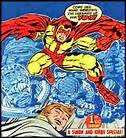 I'm sure that anybody with even a casual interest in Jack Kirby
knows that the copyright/creator issue involving the heirs of Jack Kirby
and Walt Disney/Marvel has gone/is preparing to go
back to court again. I hope this time it works in Jack's favor. Maybe the third time
is a charm. The biggest obstacle to overcome - and this is only
conjecture on my part - seems to be the lack of credible witnesses on
the part of the heirs of Jack Kirby. And I only say this because so
many of the artists and writers who were around Marvel in the
early-to-mid-to-late 1960's are no longer with us. Long time Kirby
collaborator Joe Simon is gone and so is Wally Wood, Don Heck and a
host of others. On the other hand, Stan Lee is still with us and it's
hard to cross-examine the guy when he's the only guy left standing.
I'm sure that anybody with even a casual interest in Jack Kirby
knows that the copyright/creator issue involving the heirs of Jack Kirby
and Walt Disney/Marvel has gone/is preparing to go
back to court again. I hope this time it works in Jack's favor. Maybe the third time
is a charm. The biggest obstacle to overcome - and this is only
conjecture on my part - seems to be the lack of credible witnesses on
the part of the heirs of Jack Kirby. And I only say this because so
many of the artists and writers who were around Marvel in the
early-to-mid-to-late 1960's are no longer with us. Long time Kirby
collaborator Joe Simon is gone and so is Wally Wood, Don Heck and a
host of others. On the other hand, Stan Lee is still with us and it's
hard to cross-examine the guy when he's the only guy left standing.
I don't think I'm the only person who has made note of this fact. I don't know all the details of the last Kirby vs Disney/Marvel encounter but if memory serves me right, two of the more knowledgeable witnesses who could talk in Jack's favor - that would be Mark Evanier and John Morrow - were pretty much shut down or discounted because they weren't actually around to witness the creative process involving Jack and Stan. I wonder how this argument will be circumvented this time time around. Because really, how the heck do you dispute anything Stan Lee says if all his contemporaries are sleeping in a pine box in Forest Lawn?
The website 20th Century Danny Boy addresses the Jack vs Stan argument and uses Stan's court testimony vs snippets of Jack's famous 1990 interview with Gary Groth (when Jack was deep in trying to get his original artwork back) as the basis for its point/counter-point. In fact, the DB article makes a point of saying that Stan would never lie under oath. I would only mention (again) that if no one is alive to dispute what Stan is saying then what does he have to lose?
 If you link to the Groth interview, I can tell you the reader responses are almost as interesting as the interview itself. Somewhere tucked away in a cardboard box I have that original interview. Unfortunately, so much of the history of comics is "tucked away in a box" as well and most of the younger generation of fans and artists has only the revisionist history of Stan Lee to take as fact. I would encourage anyone who wants to be a student of the game to take advantage of Google or any other resource and learn about the comics Golden and Silver Age.
If you link to the Groth interview, I can tell you the reader responses are almost as interesting as the interview itself. Somewhere tucked away in a cardboard box I have that original interview. Unfortunately, so much of the history of comics is "tucked away in a box" as well and most of the younger generation of fans and artists has only the revisionist history of Stan Lee to take as fact. I would encourage anyone who wants to be a student of the game to take advantage of Google or any other resource and learn about the comics Golden and Silver Age.But I digress. The subject here is [the heirs of] Jack Kirby going up against Disney/Marvel. This is a fight that rivals anything Jack could have drawn on paper and certainly has all the drama of anything he could have written. How it ultimately ends up is beyond me but I would have that a satisfactory conclusion is the result: at the very least that Jack is given credit for his creations and co-creations and the financial rewards that come with it.












